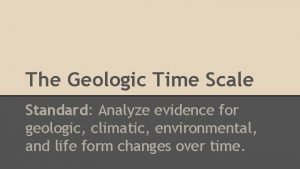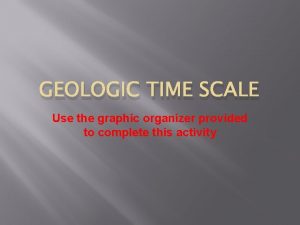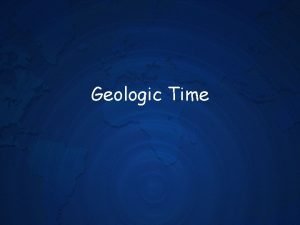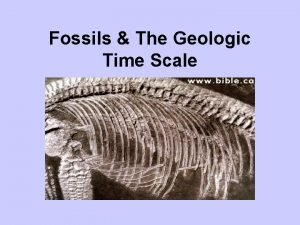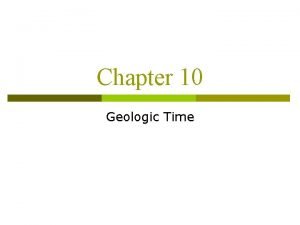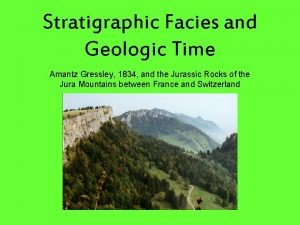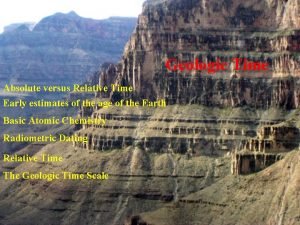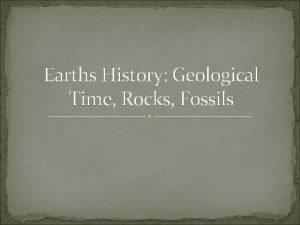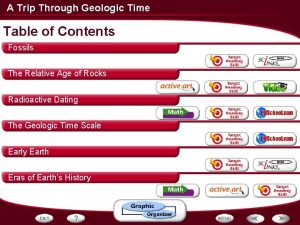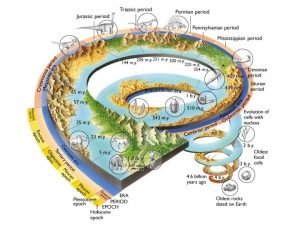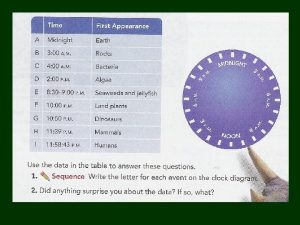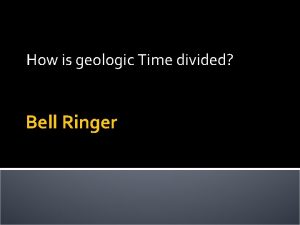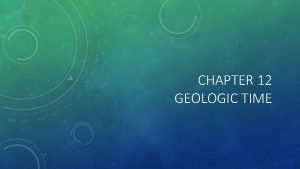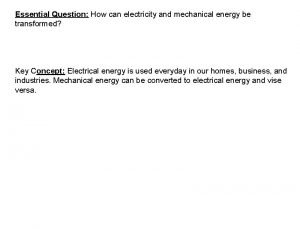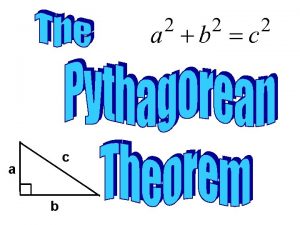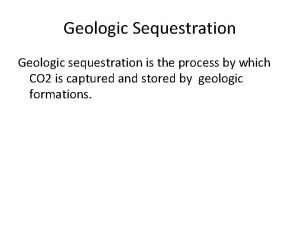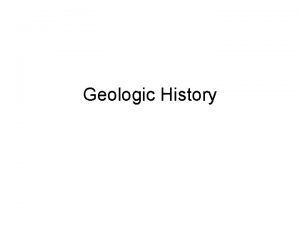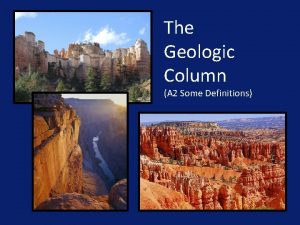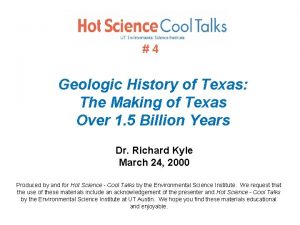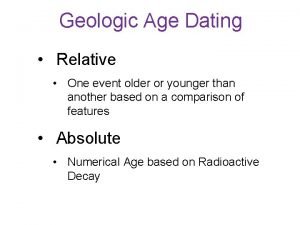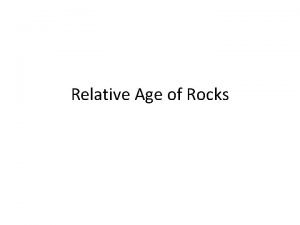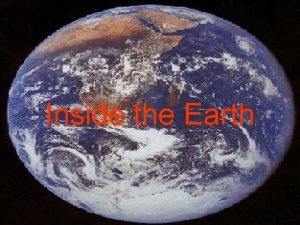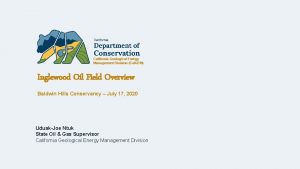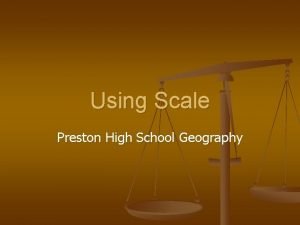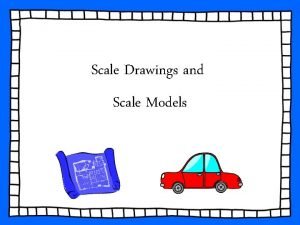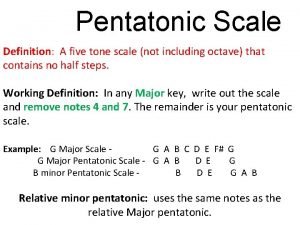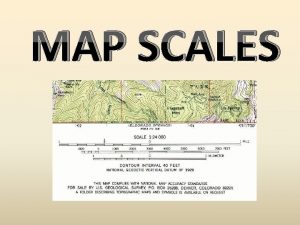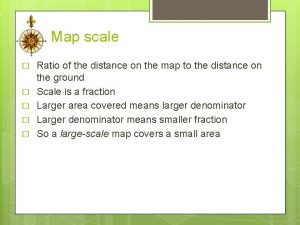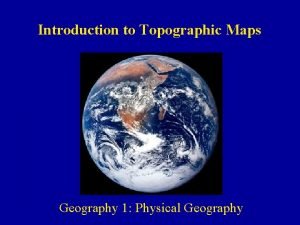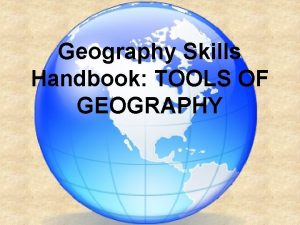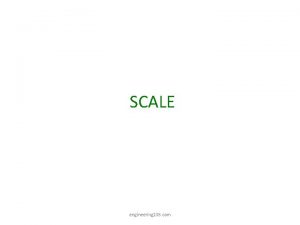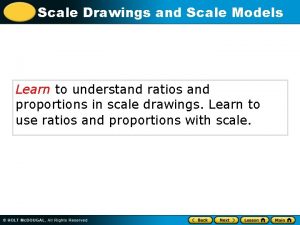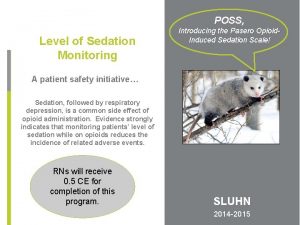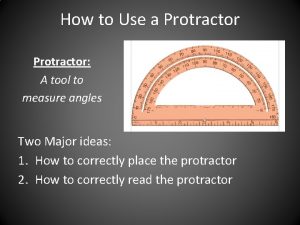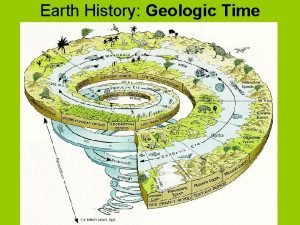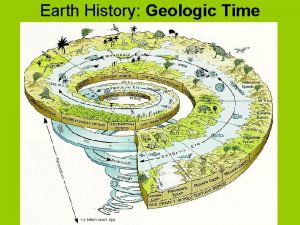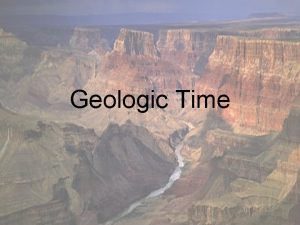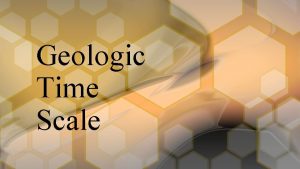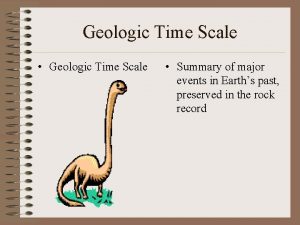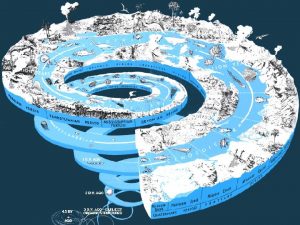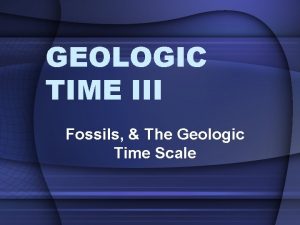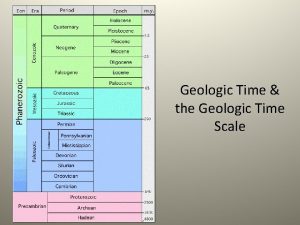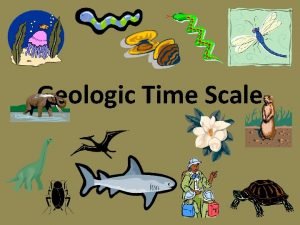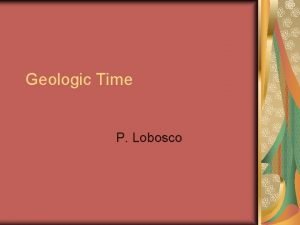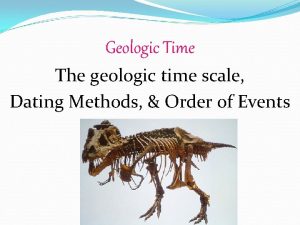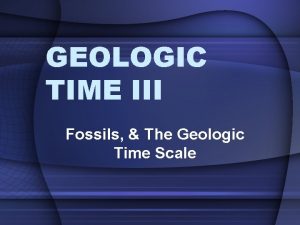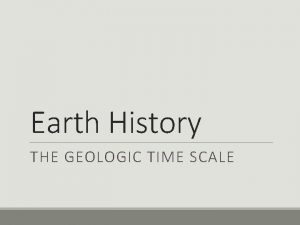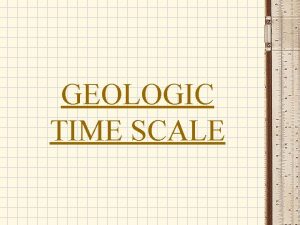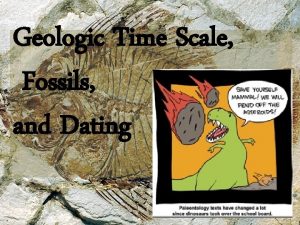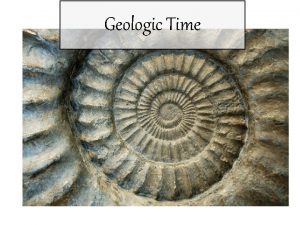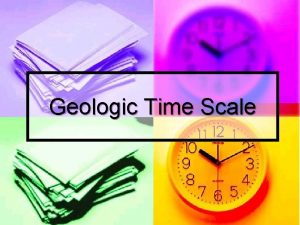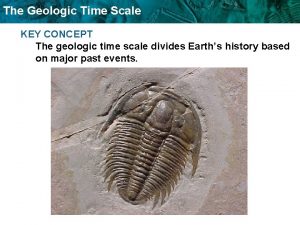Essential Question WHAT IS THE GEOLOGIC TIME SCALE



















































































- Slides: 83

Essential Question • WHAT IS THE GEOLOGIC TIME SCALE?

Standard • Standard 8. E. 6 The student will demonstrate an understanding of Earth’s geologic history and its diversity of life over time.

The Geological Time Scale Performance Indicator 8. E. 6 A. 1: Develop and use models to organize Earth’s history (including era, period, and epoch) according to the geologic time scale using evidence from rock layers.

What is the Earth’s time scale? • The geologic time scale is a record of the major events and diversity of life forms present in Earth’s history. The geologic time scale began when Earth was formed and goes on until the present. It divides Earth’s long history into units of time. • Scientists developed the time scale by studying rock layers and fossils world wide.

What about the Geologic Time Scale? • Precambrian is the name given to the earliest span of time in Earth history.

Reading and About the geologic time scale divisions • The geologic history of the Earth is broken up into hierarchical chunks of time. From largest to smallest, this hierarchy includes EONS, ERAS, PERIODS, AND EPOCHS. All of these are displayed in the portion of the geologic time scale shown below.

• The geologic time scale divides Earth’s long history into units of time: There are 4 major subdivisions of Geologic Time • Eons which subdivides into eras • Eras which subdivides into periods • Periods which subdivides into epochs BIG E = E + P = EP Eons Eras Periods Epochs

• These subdivisions are based on large scale events in Earth’s history that are identified in the fossil record and rock layers.

• The Phanerozoic Eon is subdivided into three major divisions: the PALEOZOIC, MESOZOIC, AND CENOZOIC Eras. The " -zoic" suffix comes from the root "zoo, " which means animal. • • Cen-" means __RECENT_, "Meso-" means _MIDDLE__, and "Paleo-" means ___ANCIENT_.

What is the present day or modern day Eon, Era, Period, and EPOCH we live in? • EON: PHANEROZOIC • ERA: CENOZOIC • PERIOD: QUARTNERY • EPOCH: HOLOCENE

• Cambrian being the first period is important. • With a more complete fossil record available, the periods of the Cenozoic era are subdivided further into epochs. • Geologic time has not ended.

• At the end of each era a major mass extinction occurred, many kinds of organisms died out, although there were other extinctions going on during each period of geologic time. • The layers of rock on Earth serve as evidence when identifying the geologic time scale. Using the fossil record, paleontologists (scientist who studies fossils) have created a picture of the different types of common organisms in each geologic period.

Check Point 1. Name the divisions in order from the largest to the smallest? 2. Name the divisions in order from the smallest to the largest? 3. Name the 3 Eras. 4. What is the present day or modern day Eon, Era, Period, and EPOCH we live in? 5. Triassic is a _____ 6. Precambrian has ____ Eons. 7. Name the 1 st period and which Era do it belong to? 8. ________ is the only Era that contains epochs. 9. All Eras end with the suffix _______. 10. All epochs end with the suffix _________. 11. Has the Geologic time ended? How do you know?

Different types of Geologic Time Scale




Major information found on the geologic time scale includes: • During the first billion years of Earth’s history, the land was covered with volcanoes. Over the next 3 billion years, simple life-forms began to live in oceans.

• TAKING A LOOK AT EACH DIVISION

The Precambrian Time!

The Precambrian Record

EARTH DURING PRECAMBRIAN TIME

TIMEFRAME • 4. 6 billion to 544 million years ago

IMPORTANT FACTS - Earliest part of Earth’s history - covered approximately 88% of Earth’s history which makes it the longest part of Earth’s history. • Earth formed • Life arose • First tectonic plates arose and began to move • Atmosphere became enriched in oxygen • Is known as a Supereon because it is divided into 3 eons (Proterozoic, Achaean, and Hadean)

Precambrian Time

Animals (Biological) Features • Most organisms had soft bodies which looked like modern jellyfish and worms Many Precambrian fossils are Trace fossils.

630 MYA Precambrian Time • Multicellular organisms evolve with soft bodies Species include: jelly fish; coral stalks; segmented worms; algae

Animals (Biological) Features Land (Geological) Features • Primarily covered by the ocean • Had a lot of volcanic activity

MASS EXTINCTION • MASS EXTINCTION IS THE EVENT THAT ENDED PRECAMBRIAN TIME. • * glaciation event • Precambrian time were marked by a prolonged global ice age. This may have led to widespread extinctions.

Check Point 1. Precambrian Time was mostly covered by what? 2. Precambrian Time was the ______ part of the Earth’s history 3. What types of animals lived during Precambrian time? 4. Precambrian Time is known as a ____ because it contains 3 eons. 5. What caused the mass extinction of Precambrian Time?


PALEOZOIC ERA • KNOWN AS THE AGE OF FISH OR TRILOBITES


Paleozoic Era Timeframe • 544 million to 248 million years ago

Paleozoic Era Life starts in the seas and moves onto land Six periods: Cambrian Ordovician Silurian Devonian Carboniferous-2 periods included Permian

Important Facts • Pangea was forming during this era as far as coming together • Cambrian being the first period is important. • The Cambrian Explosion was a time where there was a relatively rapid appearance of most major animal phyla as evidenced by the fossil record.

Cambrian “explosion” For reasons unclear, 13 million years after the start of the Cambrian (so 530 my), there was a tremendous diversification of marine life forms, some of which have never been reproduced. Cambrian Explosion – Most major animal phyla are found in the fossil record (mostly aquatic invertebrates with exoskeletons).

Animals (Biological) Features • Began with the early invertebrates, such as trilobites and brachiopods WHAT FIRST APPEARED: 1. Trilobites 2. fish 3. arachnids and insects 4. first amphibians 5. near the era’s end the reptiles became dominant. WHAT BECAME DOMINANT: 1. Trilobites 2. Fish

Trilobites • Lived in Earth’s ancient seas • Extinct before the dinosaurs came into existence • Cambrian Period is know as the “Age of the Trilobites” (put in on table)

Brachiopods • Marine animals that resemble clams.

Early Fish Early fish did not have jaws. Some species of sharks were in existence at this time.

Frilled Shark that was found in Japan in January 2007. This shark was considered a “living fossil”

Land (Geological) Features • During most of the Era, warm shallow seas covered much of the planet. WHAT FIRST APPEARED: 1. Simple mosses 2. Ferns 3. Cone-bearing plants 4. Seed plants

Early Land Plants Mosses Cone bearing plants Ferns

HOW EARTH LOOKED DURING THE PALEOZOIC ERA


Mass Extinction • The mass extinction that ended the era caused most marine invertebrates as well as amphibians to disappear. • About 95 percent of marine species and 70 percent of land animals were wiped out after the Permian mass extinction. • It is suspected that periods of rapid global warming and cooling that happened so quickly most organisms were not able to adjust.

WHAT CATASTROPHIC EVENT CAUSED THE MASS EXTINCTION? ? ? 3 THINGS • 1. volcanic activity • 2. Climate Changes • 3. lowering of sea levels as Pangaea was forming (convergent boundaries)

Mesozoic Era (Age of the Dinosaurs or Reptiles) Three Periods Triassic Jurassic Cretaceous


TIMEFRAME • Occurred between 248 to 65 million years ago

IMPORTANT FACTS • Time marked by rapid movements of plates • A major geologic event of the Mesozoic was the break-up of the super continent of Pangaea into several large continents. • At the beginning of this era Pangaea formed and during the Triassic Period

Mesozoic Era Triassic Period (225 -180 MYA) Pangaea (supercontinent) existed

PANGAEA

Mesozoic Era Jurassic Period Pangaea starts to separate (180 -135 MYA)

Mesozoic Era Cretaceous Period Continents in modern positions (135 -65 MYA)

ANIMALS/ORGANISMS (BIOLOGICAL) WHAT FIRST APPEARED? 1. DINOSAURS 2. SMALL MAMMALS 3. BIRDS WHAT ANIMAILS BECAME DOMINANT? 1. DINOSAURS 2. REPTILES

Mesozoic Era Triassic Period (225 -180 MYA) First Dinosaurs (small in size) Pisanosaurus Length: 3 feet Height: 1 foot Weight: 15 pounds Eoraptor: Length: 3 feet Height: 1 foot Weight: 20 pounds

Mesozoic Era Jurassic Period 1 st mammals (small rodents). (180 -135 MYA)

Mesozoic Era Jurassic Period (180 -135 MYA) 1 st birds (Archaeopteryx). • Jaws and bone structure like dinosaurs • Bones are hollow, like birds • Had feathers

LAND (GEOLOGICAL) FEATURES • WHAT LAND FEATURES FIRST APPEARED? 1. Flowering plants • WHAT LAND FEATURES BECAME DOMINANT? • 1. SEED PANTS

Mesozoic Era Cretaceous Period Flower plants CALLED (angiosperms) 1 ST APPEARED (135 -65 MYA)

• WHAT CATASTROPHIC EVENT CAUSED THE MASS EXTINCTION? • Scientists hypothesize that possibly a large _asteroids__ or _comets__ impacted with Earth. • The mass extinction that ended the era caused the dinosaurs to become extinct.

MASS EXTINCTION • Asteroids, METEORITE, or Comets collided into the Earth AND CAUSED Mass Extinction




How could a meteorite impact cause a mass extinction? • The impact caused shock waves, tidal waves, and sent a tremendous amount of dust into the atmosphere As the dust re-entered the Earth’s atmosphere, it would have instantly heated the atmosphere causing tremendous forest fires p Dust from impact blocked out the sun and caused major climate change and plants to die p Plants, animals, etc. went extinct due to the climate changes and competition between organisms p

Cenozoic Era (Age of the Mammals) Two Periods Tertiary Quaternary

TIMEFRAME • TIMEFRAME: 65 million years ago to Present Day

IMPORTANT FACTS: • Present day Earth is in this era. • The diversity of life forms increased because of the variety of different animal and plant species that formed. • New mammals appeared while others became extinct. • A major geologic event of the Cenozoic is the further splitting and moving of continents to their current positions.



ANIMALS/ORGANISMS (BIOLOGICAL) • WHAT MAMMALS/ANIMALS FIRST APPEARED? 1. Humans WHAT MAMMALS/ANIMALS BECAME DOMINANT? 1. MAMMALS

• HUMANS 1 ST APPEARED (HOMO SAPIENS)

Cenozoic Mammals

MAMMALS

GEOLOGICAL (Land) FEATURES • WHAT LAND FEATURES BECAME DOMINANT? 1. FLOWERING PLANTS

Flowering Plants were common during the Cenozoic Era


WHAT CAUSED THE MASS EXTINCTION? • There have been SOME extinctions CAUSED BY Climatic Changes & Glacier Events (Ice Ages) during the Cenozoic as there were during the Mesozoic and Paleozoic, but not as many animals and plants have disappeared. • The “Great Ice Age”, ice sheets covered 30% of all land •

The Great Ice Age

5 Question Quiz 1. 2. 3. 4. Which era is the age of dinosaurs? Which era is the age of trilobites? Which era is the age of mammals? What is the connection between periods, eons, eras, and epochs? 5. Give 2 facts about the Precambrian Time.
 Compare geologic time with the geologic column.
Compare geologic time with the geologic column. How is the geologic time scale organized
How is the geologic time scale organized Geological time scale graphic organizer
Geological time scale graphic organizer Geologic time scale in a calendar year
Geologic time scale in a calendar year Geologic time scale animals
Geologic time scale animals Geologic time scale drawing
Geologic time scale drawing Moth scale
Moth scale Nooa
Nooa Amantz
Amantz Geologic time scale poem
Geologic time scale poem Geologic time scale
Geologic time scale Geologic time scale drawing
Geologic time scale drawing Costas level of thinking
Costas level of thinking Brainpop geologic time
Brainpop geologic time A trip through geologic time answer key
A trip through geologic time answer key Largest division of geologic time
Largest division of geologic time Geologic time
Geologic time What is the longest subdivision in geologic time
What is the longest subdivision in geologic time Chapter 12 geologic time
Chapter 12 geologic time Plamatic acid
Plamatic acid Essential questions about figurative language
Essential questions about figurative language The pythagorean theorem
The pythagorean theorem Essential question generator
Essential question generator Essential questions for pythagorean theorem
Essential questions for pythagorean theorem Essential questions for figurative language
Essential questions for figurative language Individual vs society
Individual vs society Essential question for context clues
Essential question for context clues Cornell notes essential question
Cornell notes essential question Essential questions definition
Essential questions definition Essential questions for multiplication
Essential questions for multiplication Essential question gif
Essential question gif Objective traits
Objective traits Essential question cornell notes
Essential question cornell notes Essential questions for english
Essential questions for english Caprock
Caprock Definition of geologic history
Definition of geologic history Geologic column definition
Geologic column definition Geologic history of texas
Geologic history of texas Principle of superposition
Principle of superposition Disconformity
Disconformity What is relative age
What is relative age What is the center of the earth made of
What is the center of the earth made of California geologic energy management division
California geologic energy management division What is elapsed time
What is elapsed time Question words present simple
Question words present simple Advantages and disadvantages of probing questions
Advantages and disadvantages of probing questions Contoh open-ended question adalah
Contoh open-ended question adalah Factor relating questions example
Factor relating questions example Change direct questions into indirect questions
Change direct questions into indirect questions Compelling and supporting questions examples
Compelling and supporting questions examples Compelling question vs supporting question
Compelling question vs supporting question Small vs large scale maps
Small vs large scale maps 7-7 scale drawings and models practice
7-7 scale drawings and models practice Scale tones
Scale tones Scale in map definition
Scale in map definition Map scale ratio
Map scale ratio Physical and cultural features of topographic map
Physical and cultural features of topographic map Geography skills handbook
Geography skills handbook Scale up cloud
Scale up cloud Scale up and scale out in hadoop
Scale up and scale out in hadoop Understanding scale drawings
Understanding scale drawings Plain scale in engineering drawing
Plain scale in engineering drawing What is a proportional two dimensional drawing of an object
What is a proportional two dimensional drawing of an object Poss sedation scale
Poss sedation scale Scale up scale down
Scale up scale down Proper protractor orientation
Proper protractor orientation Inner scale outer scale protractor
Inner scale outer scale protractor Principle of surveying
Principle of surveying Hát kết hợp bộ gõ cơ thể
Hát kết hợp bộ gõ cơ thể Bổ thể
Bổ thể Tỉ lệ cơ thể trẻ em
Tỉ lệ cơ thể trẻ em Voi kéo gỗ như thế nào
Voi kéo gỗ như thế nào Tư thế worm breton
Tư thế worm breton Hát lên người ơi
Hát lên người ơi Các môn thể thao bắt đầu bằng tiếng bóng
Các môn thể thao bắt đầu bằng tiếng bóng Thế nào là hệ số cao nhất
Thế nào là hệ số cao nhất Các châu lục và đại dương trên thế giới
Các châu lục và đại dương trên thế giới Công thức tiính động năng
Công thức tiính động năng Trời xanh đây là của chúng ta thể thơ
Trời xanh đây là của chúng ta thể thơ Cách giải mật thư tọa độ
Cách giải mật thư tọa độ Phép trừ bù
Phép trừ bù độ dài liên kết
độ dài liên kết Các châu lục và đại dương trên thế giới
Các châu lục và đại dương trên thế giới

